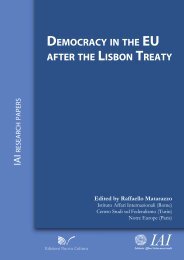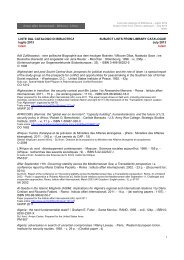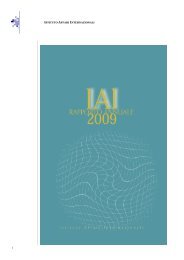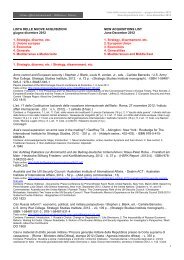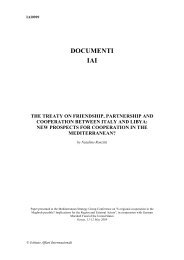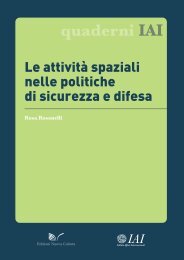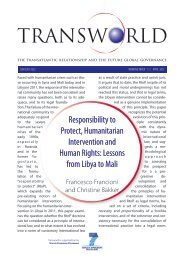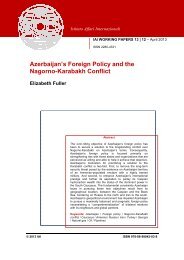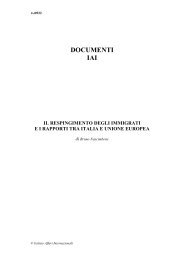La minaccia NBCR - Istituto Affari Internazionali
La minaccia NBCR - Istituto Affari Internazionali
La minaccia NBCR - Istituto Affari Internazionali
Create successful ePaper yourself
Turn your PDF publications into a flip-book with our unique Google optimized e-Paper software.
europei, nella definizione concreta di bisogni per la sicurezza da tradurre in termini di ricerca<br />
tecnologica 46 .<br />
Di questi 15 ben 3 trattano specificatamente di questioni B, mentre uno affronta il tema in<br />
maniera non esclusiva:<br />
1) Enhancing the detection and protection against biological harmful substances:<br />
Biological weapons have been a threat for many years but recent advances in biotechnology<br />
make the problem potentially more serious. Hence the escalating dangers must be controlled<br />
and detection and alarm systems developed. Biological detection technologies are in a much<br />
less mature stage of development than chemical detectors so the BODE (Biological Optical<br />
Detection Experiment) project addresses the necessity of developing a reliable, accurate,<br />
stand off detection tool for biological particles. This research project aims to identifying the<br />
functional and operational requirements of a detection apparatus and to propose a<br />
specification for a biological detection demonstrator device, to design, manufacture and<br />
integrate demonstrator elements. The consortium is composed of industrialists, research<br />
centres, and end users from six different countries.<br />
2) Designing models to predict the dispersion of microbes:<br />
The AEROBACTICS project (Assessment of the quantity, identity, viability, origin and<br />
dispersion of airborne micro-organisms for application in crisis management tools) aims to<br />
develop models to firstly better distinguish between the natural background of micro-<br />
organisms and environmental pathogenic traits, and the real biological attacks and<br />
subsequently to predict the aerial dispersion from an unwanted release. Sensor systems for<br />
bioterror detection require quantitative input about the natural background of micro-<br />
organisms and environmental pathogenic traits, in order to distinguish natural occurrences<br />
from real attacks. However, knowledge of numbers, species, viability and pathogenicity of<br />
airborne micro-organisms is extremely scarce, and models to predict background fluctuations<br />
are inadequate. AEROBACTICS is designed to close these gaps of knowledge. Two models<br />
will be developed, one for background levels and long-range dispersion, and one for the<br />
aerial dispersion from an unwanted release. Both natural events and intentional releases of<br />
micro-organisms will be utilised experimentally.<br />
46 I progetti selezionati nel quadro della PASR 2006, si svolgono a partire dal 2007: “15 new security research<br />
projects to combat terrorism”, Brussels, 13th October 2006, MEMO/06/375,<br />
http://europa.eu/rapid/pressReleasesAction.do?reference=MEMO/06/375&format=HTML&aged=0&language=<br />
EN&gui<strong>La</strong>nguage=en<br />
- 18 -





